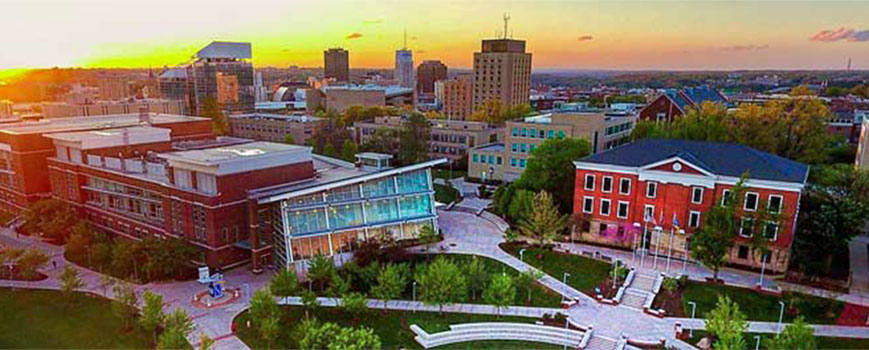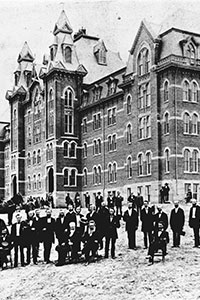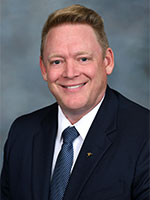
University and City shine at dusk
by Janet Chismar-Hardie '92
Local historians tell us that the City of Akron, like Rome, was built on seven hills. It seems fitting, then, that the university bearing its name also has a hill story.
Founded in 1870 by the Ohio Universalist Convention, Buchtel College sat atop a 2.6-acre hilltop near the center of town. The fledging college was strongly influenced by the efforts, energy and financial support of Akronites, particularly industrialist John R. Buchtel.
From the outset, the college and the surrounding community were closely tied, with local entrepreneurs assisting the new institution and the college addressing the needs of the region.
By 1913, Buchtel College trustees transferred the institution and its assets to the City of Akron.
For the next 50 years, the municipal University of Akron, assisted by local tax funds, brought college education within the reach of many young people. Then, In 1967, The University of Akron (UA) became one of Ohio’s state universities. Access to state funding enabled continued growth not possible for a municipal university. But the strong partnership remained—and it flourishes to this day. 
The City and the University continue to grow together both geographically—with the expansion of campus into downtown—and ideologically with a shared vision of improving the community.
And it all starts in the classroom.
Meet the sisters
You need not look any further than Akron Public Schools (APS) to find an example of a strong partnership: administrators often describe the relationship between APS and UA as “robust.” In fact, UA has three “sister schools”—two of which are located on its campus.
The National Inventors Hall of Fame (NIHF) STEM High School found a home in the former Central Hower High School building. Because it is a lottery school, students represent a diverse cross section of the city.
To give them a taste of college life and get them interested in becoming Zips, UA faculty often create experiential opportunities that allow these students to walk through labs on campus or check out the Rec Center. No wonder, then, that a high number of NIHF students choose to continue their education at UA after graduation.
The other on-campus sister school, Akron Early College High School, is located inside the Polsky Building. Students who want to attend first must take the initiative to fill out an application while they are in 8th grade. If accepted, they have the potential to earn an associate degree from UA simultaneously with their high school diploma.
UA also has a sister relationship with Ellet High School; most of the students who attend live in that neighborhood, and a high number of the students who do choose to go to college, choose UA.
A three-pronged approach
To engage with each school, the University uses three engagement strategies. First, a professor may help a high school teacher in designing curriculum that allows their students to investigate career options. The classes will then visit UA to interact with campus professionals in various roles.
They might tour UA’s computer center to see what a career in IT looks like. They might explore HVAC facilities or use a drone. Or, UA athletics marketing staff may walk students through James A. Rhodes arena, explaining how to create a contract with an advertiser.
The next area of engagement involves professional development for APS teachers. You’ll often see teachers working with UA’s LeBron James Family Foundation School of Education to learn the newest instructional strategies to advance their careers.
The third category involves supporting students’ families. At the high school level, that means helping with college applications or with filling out the FAFSA, which can be daunting for a first-generation college student. Staff from UA Admissions and Financial Aid teams often sit down with families one-on-one to take the fear out of completing forms.
Impacting the district
The School of Education, by nature, reaches beyond UA’s sister schools to impact the entirety of the APS district. Many UA education majors complete either observation or their student teaching in one of the various Akron schools. The School of Education may also work alongside a particular school that asks for help creating a specific experience.
For example, teachers at nearby Miller South, a middle school for the visual and performing arts, noticed that some students lacked interest in math. In response, faculty in the Myers School of Art created modules to show how mathematics is represented in the arts—things like using measurements and chemistry to create paints or pointing out patterns and repetition in famous works of art.
“The University of Akron is deeply rooted in our communities and we are more robust and unique because of our diverse services and partnerships,” noted President Gary L. Miller in a recent address. “And there is no better place to begin than with our schools.”
The head of the class: Meet Steve McKellips
 As the vice provost for enrollment management, Stephen McKellips provides leadership and engages in innovative approaches to enrollment management and decision-making for the areas of admissions/recruitment, financial aid services and enrollment.
As the vice provost for enrollment management, Stephen McKellips provides leadership and engages in innovative approaches to enrollment management and decision-making for the areas of admissions/recruitment, financial aid services and enrollment.
“Basically, what I am trying to do at the enrollment level, is live up to what the recruitment office said would happen when we told students this is the best place for them to be,” said McKellips.
As it relates to Akron Public Schools (APS) and the City in general, McKellips thinks it is important that the University prioritizes its relationship with both. “We’re their neighbor and a substantial presence in Akron.”
If APS represents the heartbeat of the community and its future, then “we at UA have to function like its [APS] success plays an integral role in our success. We cannot accomplish our goals without them, nor can they be wholly successful without us.”
McKellips concluded, “We must connect with the city’s identity and incorporate APS into ours. You don’t have to be a student to be part of the community of scholars here at UA.”
Related:
